CRL Reports: Chest from the Brother Jonathan Shipwreck
California State Lands Commission / Institute for Western Maritime Archaeology
The Brother Jonathan crate was shipped to the Conservation Research Laboratory on October 17, 2000, but the conservation work did not begin until January of 2001. The conservation plan is simple. The goals of the project are to: 1) determine the contents of the crate; 2) determine the way the crate was packed; 3) identify each of the artifacts; 4) evaluate the condition of each artifact; and, 5) devise a conservation treatment for each of the artifacts.
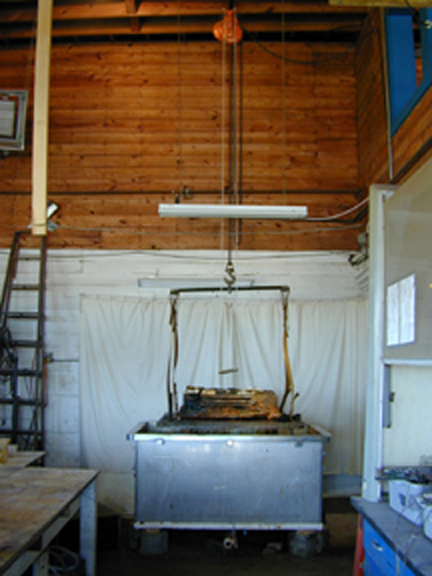
The stainless steel vat, the crate on the fiberglass grate, and the electric chain hoist installed over the vat.
As is the case with all encrusted metal and organic material from underwater sites, it is necessary to keep the material wet at all times. When not being worked on, the crate is stored in a solution of 5% sodium sesquicarbonate mixed with tap water. When the conservator is working on the crate, it is kept wet using a stream of water pumped from the vat. To facilitate the documentation and the conservation work, a large stainless steel vat was placed in a corner of the conservation laboratory. A web cam was installed over the vat to document the work, a white vinyl curtain was installed behind the vat and daylight balance fluorescent lights for daylight are installed over the vat. The crate was placed on a fiberglass grate and an electric chain hoist was installed over the vat. This enables the worker to raise and lower the crate unassisted and with ease. Since the webcam is continuously broadcasting and saving images of the ongoing work, the work surfaces of the crate are labeled in plan view from the perspective of the web camera — top, north, south, east, west. The south side is exposed to the camera, and in typical plan view, north is up.
As of June 1, 2001, approximately one third of the chest had been successfully excavated. At present, we are only prepared to state that the crate appears to be a shipment of miscellaneous hardware bound for a British Columbia store for resale because all the material appears in multiple quantities. We found that the crate was constructed of thin boards, which are largely gone through the action of teredo worms and other marine organisms. It appears that the planks were approximately 10 mm. The exterior dimensions of the crate were 85 cm x 70 cm x 30 cm. It was thought that the crate had originally been bound with rope as there was an alignment of ropes going across the top, but this was found to be rope around two bundles of scythes.
The interior of the box was lined with tin sheeting which was soldered with lead at the junctures. The tin sheeting has for the most part deteriorated; however, the soldered seams are in good condition. The box was carefully and tightly packed with an array of material. Most of the objects were grouped into like items and carefully packaged and wrapped in paper, some of which still have the faint remains of a label.
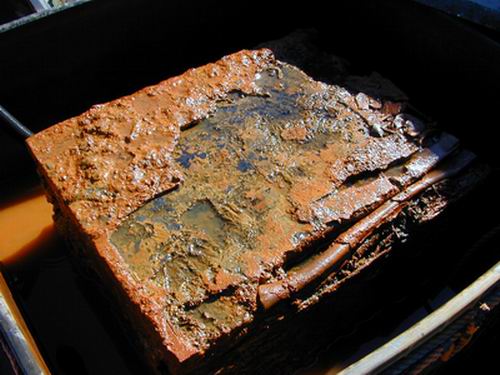
View of the “top” of the crate as it was received for conservation
An interesting array of artifacts have been identified. These include: hafted axes and hatchets, cast iron meat grinders and detached handles with wood hand grips, iron scythes, brass keys, brass plumb bobs, cast iron pulleys, iron hooks, cast iron window sash guides, and some yet to be identified artifacts.
The primary tool to excavate out the heavily encrusted objects is a Chicago Pneumatic Air Scribe, assisted with an array of thin metal strips and other assorted tools. During the excavation, water is run over the artifacts to keep them wet. As each artifacts is removed it is placed in separate vats of 5% sodium sesquicarbonate aqueous solution to prevent any corrosion.

“Top” designates the top of the working area, the area that is uppermost on the crate. “South” and “North” designate parallel sides that are the longer length of the crate. “East” and “West” designate the sides that are the shorter sides of the crate. In the photograph above and the plan drawing to the right, the south side is at the lower right, while the north side is at the upper left. The east side is to the right and the west is to the left. .
To facilitate the following description the work surfaces of the crate have been designated as described above and as indicated in the plan to the left.
In the color photograph above, the hafted axes are located at the top of the crate and down the south side.
The wood found associated with or part of the artifacts in the crate is in very good condition, but the iron (both cast and wrought) such as the axe and hatchet heads are gone as a result of extensive corrosion. For most of the iron artifacts, the only way to recover them is by casting the voids left by the corroding iron with epoxy. In contrast the non-ferrous artifacts, such as the brass plumb bobs are in excellent condition. The corroding iron has obviously provided the non-ferrous metal with galvanic protection. The paper that is wrapped around the packages and the string wrapped around the paper are in varying states of preservation, ranging from very good, to totally disintegrated. In some instances the remains of labels can be seen on the packages.
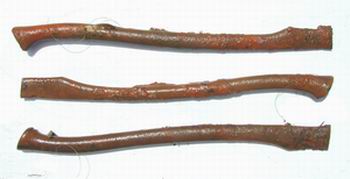
Three of the axe handles after conservation.
Twelve hafted axes were stacked along the south side of the crate. The top wood handle can be seen in the photograph above. The iron axe heads was wrapped in paper and alternately stacked with the blade on one axe laying along the poll of the adjacent axe. The axe heads were completely deteriorated and a natural mold of some of the axe heads is preserved within the wrapping paper. In some instances it is hoped that these voids can be filled with epoxy to form a mold of the axe head.
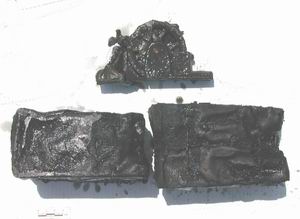
Two packages of cast iron pulleys shown wrapped in paper, with a single pulley above.
Three packages of cast iron pulleys (possibly sash window weight pulleys) were placed just north of the the axe heads. Two of the packages are shown to the left. Each package contains four pulleys, one of which is shown above the two packages. It is exciting to find the wrapping paper so well preserved. It is hoped that as the conservation of the paper is completed the stains can be removed and any identifying labels will be legible. Each paper package containing the pulleys is tied securely with string. Three additional packages of pulleys (for a total of 24 pulleys) were found in the opposite (north-west) corner of the crate. The conservation of the paper and the pulleys has not begun; however the paper will be folded back so the pulleys can be extracted. they will then be conserved individually by different processes.

Two rope wrapped bundles believed to be iron scythes. The rope was to protect the blades during shipping.
In the center of the top surface there were two rope wrapped bundles that, based on the x-rays, we believe to be iron scythes, They are wrapped in rope to protect the blades. The white epoxy at the the lower left of the photograph is a cast of the corroded handle on one of the scythes. The x-rays indicate that there are six scythes in each rope-wrapped bundle. At the center of both bundles the faint outline of a rectangular paper label can be seen. These may be a manufacturers’ label that identifies the contents. Hopefully, during the conservation, some of the paper will be preserved and the writing will be legible. If so, then additional information can be gained about these tools.
The hafted axes can be seen along the south side of the crate. In the upper left (NW corner) and continuing down the west side is a small hafted hatchet (this was under the second group of pulley packages). The impression of the corroded scythe hafting tang on one of the scythes has been cast with white epoxy.
Along the south side, overlapping the axe handles are two cast iron handles for the meat grinders. Each has a wood hand grip, easily seen in the photograph below. The cast iron is very graphitized with little remaining iron. When the handles were removed, the fragile iron broke into several pieces, but they can be easily reassembled. Four meat grinders were found in the crate — two small ones and two large ones. On the right, below, are examples of the two different sizes of meat grinders. Cast into the top of both sizes were the markings, “PATENTED / MARCH 1(?) / 1859”. By searching in the U.S. Patent Office archives we found a patent issued to Albert W. Hale on March 15, 1859. The plans for the patented meat grinders are slightly different from those recovered here, but it is obvious that they are the same patented design. To date, only two handles have been found, so another two must be in the crate somewhere.
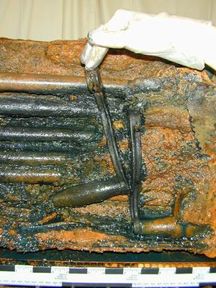 Two cast iron handles for the meat grinders. Each has a wooden hand grip. |
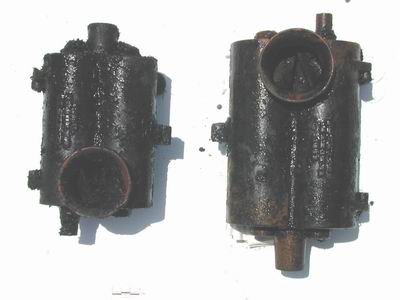 Examples of the two different sizes of meat grinders found in the crate. |
Below is a picture of the inside of one of the large meat grinders. The cast iron is badly graphitized and little iron remains. They have a very weak magnetic attraction. Still the overall preservation is good. In fact, the ease with which they came apart is amazing!
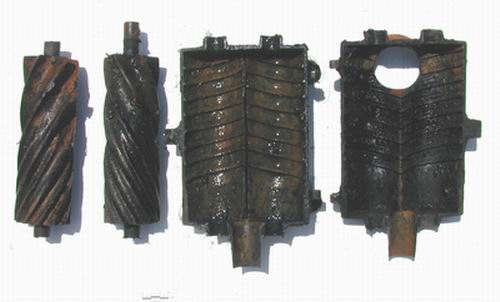
Photo of the inside of one of the large meat grinders disassembled.
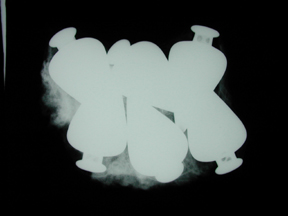
An X-ray of a small, paper-wrapped package containing six brass plumb bobs
To the right is an X-ray of a small, paper-wrapped package containing six brass plumb bobs. Other brass artifacts identified to date include brass rivets in the pulleys, two keys, and what appears to some sort of locking mechanism — perhaps a door lock or a clock.
A number of unidentified artifacts have been removed and more remain partially exposed in the crate. What was originally thought to be a leather boot turned in the first report was found to be part of one of the paper-wrapped packages.
The conservation of the crate, analysis of its contents, and pertinent background research is the subject of a Master’s thesis by Carrie Sowden, a student in Nautical Archaeology at Texas A&M University. Who knows what awaits Carrie as she continues to reveal the two thirds of the crated that remains. The conservation of the artifacts recovered to date has started and will continue over the summer.
Excavation and conservation of artifacts from the Brother Jonathan crate
Citation Information:
- Carrie E. Sowden, Helen Dewolf, and Donny L. Hamilton
- 2001 The Brother Jonathan Crate: Opening the Crate, Conservation Research Laboratory Research Report 12-1, World Wide Web, URL, https://liberalarts.tamu.edu/nautarch/reportlist/crl-reports-chest-from-the-brother-jonathan-shipwreck/, Nautical Archaeology Program, Texas A&M University.Email: carriees@hotmail.com
